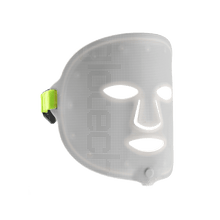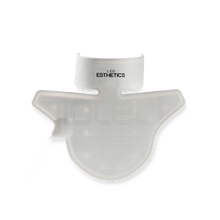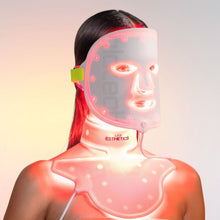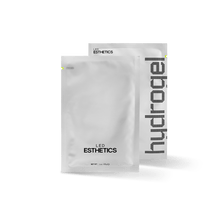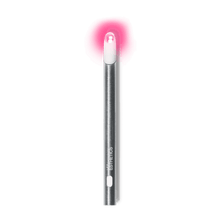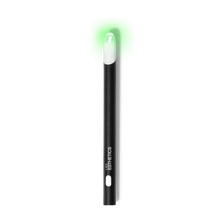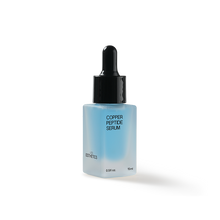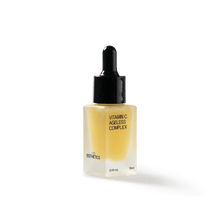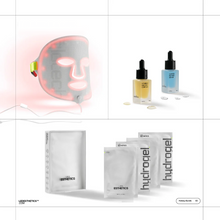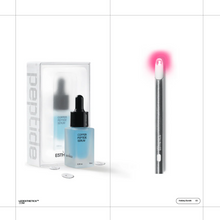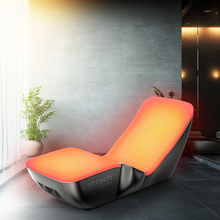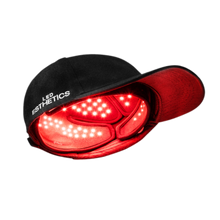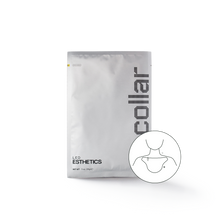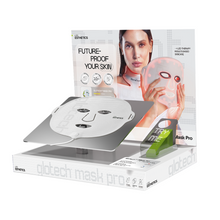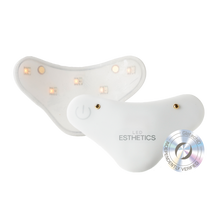
Collagen Density in Neck Skin: Why LED Therapy Works Differently Below the Jawline
|
|
Time to read 7 min
|
|
Time to read 7 min
LED-SCIENCE [10-28-2025]
BY MADISON CARTER
Your neck reveals your age faster than your face, and the reason lies in its cellular structure. Neck skin contains 20-40% less collagen density than facial skin, making it more vulnerable to visible aging. This fundamental difference explains why even the most diligent facial skincare routines often leave the décolletage behind.
The skin below your jawline is also significantly thinner, with fewer sebaceous glands producing protective oils. This creates a perfect storm for premature aging, where wrinkles, crepiness, and sagging appear years earlier. Understanding these structural differences is essential for developing an effective treatment approach.
Dermatologists have long recognized that the neck and chest require specialized treatment protocols, not just extensions of facial care. The unique composition of cervical skin means it responds differently to various interventions, including LED light therapy. This is where wavelength-specific photobiomodulation becomes crucial for targeting the distinct needs of décolletage tissue.
Collagen degradation in the neck accelerates due to three primary factors: constant movement, sun exposure, and reduced structural support. Every time you look down at your phone or computer, you create horizontal compression lines. These repeated movements, combined with chronic UV exposure on this often-unprotected area, break down existing collagen faster.
The dermis in your neck contains fewer fibroblasts, the cells responsible for producing new collagen and elastin. With less regenerative capacity and constant environmental stress, the skin structure progressively weakens over time. This process typically begins in your late twenties, well before facial aging becomes apparent.
LED light therapy works by delivering specific wavelengths directly to skin cells, triggering photobiomodulation at the mitochondrial level. Red light at 660nm penetrates the epidermis and upper dermis, stimulating fibroblast activity and collagen synthesis. This wavelength has been clinically shown to increase collagen production by up to 31% in treated areas.
Near-infrared light at 850nm penetrates even deeper, reaching the lower dermal layers where structural support originates. This deeper penetration is particularly important for neck skin, where rebuilding the foundational matrix requires cellular activation. The combination of these wavelengths creates a comprehensive approach to addressing multi-layered collagen depletion.
The effectiveness of LED therapy depends entirely on using clinically-proven wavelengths at therapeutic energy densities. Research demonstrates that 660nm red light specifically activates Type I and Type III collagen production, the primary structural proteins. Random or unverified wavelengths simply cannot produce the same biological response in target tissues.
For neck skin's unique challenges, the penetration depth becomes even more critical than for facial applications. Surface-level treatments cannot reach the dermal layers where significant collagen loss occurs and must be reversed. This is why professional-grade devices with validated wavelengths outperform consumer products with unspecified or weak light output.
FDA clearance matters because it verifies that a device delivers therapeutic wavelengths at safe, effective energy levels. Without this validation, you're essentially hoping that a device works rather than knowing it does. LED Esthetics maintains this clinical standard across all products, ensuring reliable results for neck treatment protocols.
The Glotech Collar is specifically engineered to address the neck and décolletage area with clinical-grade 660nm and 850nm wavelengths. Its ergonomic design ensures consistent light delivery across the curved surfaces of your neck and chest area. This targeted approach recognizes that your neck requires different treatment parameters than your face for optimal results.
When LED wavelengths reach skin cells, they're absorbed by chromophores within the mitochondria, specifically cytochrome c oxidase. This absorption triggers increased ATP production, giving cells the energy needed to perform repair and regeneration functions. For fibroblasts, this energy boost directly translates to increased collagen and elastin synthesis.
The process also modulates inflammatory pathways, reducing the chronic low-grade inflammation that accelerates collagen breakdown in aging skin. By decreasing matrix metalloproteinases (MMPs), LED therapy prevents the enzymatic degradation of existing collagen structures. This dual action—building new collagen while protecting existing fibers—creates cumulative improvements over treatment sessions.
Research published in dermatology journals has documented these mechanisms through histological analysis of treated versus untreated skin samples. The evidence shows measurable increases in dermal thickness, collagen fiber density, and improved organization of the extracellular matrix. These aren't subjective improvements but quantifiable changes in skin structure that translate to visible rejuvenation.
Another clinical trial focused on chest skin damaged by chronic sun exposure showed remarkable improvements in pigmentation and texture. The combination of red and near-infrared wavelengths proved most effective for addressing multiple signs of aging simultaneously. These studies used treatment protocols of 10-20 minutes, 3-5 times weekly, establishing the evidence-based approach for optimal results.
The research consistently shows that neck collagen LED therapy requires sustained use over weeks to months for maximum benefit. Unlike invasive procedures that provide immediate but temporary results, LED therapy builds structural improvements that continue developing over time. This makes it an ideal long-term strategy for maintaining neck and chest skin health.
For those interested in understanding more about how different wavelengths work throughout the body, our article "Red Light vs. Blue Light vs. Near-Infrared: Which Wavelength Does What?" provides comprehensive explanations of each spectrum's specific biological effects.
Consistency matters more than intensity when developing an effective LED therapy routine for neck collagen restoration. Start with 10-minute sessions three times weekly, positioning the device to ensure even light distribution across treatment areas. The neck's contours require careful attention to avoid missing areas that won't receive therapeutic light exposure.
Combine LED therapy with appropriate skincare products that support collagen production, such as peptides, retinoids, and antioxidants. The photobiomodulation effect enhances the penetration and efficacy of topically applied active ingredients when used together. Apply your skincare immediately after LED treatment when cellular activity is elevated for maximum absorption and benefit.
Track your progress with photos taken in consistent lighting every two weeks to document subtle improvements. Neck skin changes gradually, so visual documentation helps you recognize improvements that might otherwise go unnoticed with daily observation. Most users report visible improvements in skin texture and firmness within 6-8 weeks of consistent use.
I love the collar so far. I have already seen a difference in the skin on my upper chest. It is decreasing the spots on my skin and the texture on my neck. I use it every night.
- Kim
LED therapy works synergistically with other non-invasive treatments to amplify collagen-building results in neck skin. Microcurrent therapy enhances muscle tone beneath the skin, providing additional support for improved contours and reduced sagging. When combined with LED's collagen-stimulating effects, the improvements address both structural and muscular components of neck aging.
Professional treatments like microneedling create controlled micro-injuries that trigger the body's healing response, including collagen production. Following microneedling with LED therapy accelerates the healing process while maximizing collagen synthesis during the recovery period. Many dermatologists now incorporate LED therapy into their post-procedure protocols for enhanced outcomes and faster recovery.
Many people apply LED therapy inconsistently, treating their neck only occasionally or when they remember their skincare routine. This sporadic approach prevents the cumulative cellular changes necessary for visible collagen improvements in neck tissue. Biological processes require sustained signaling to produce lasting structural changes, making regular treatments essential for results.
Another frequent error involves using devices without verified wavelengths or adequate energy output for therapeutic effects. Consumer-grade beauty devices often lack the power density necessary to penetrate neck skin and reach target cells effectively. Without FDA clearance or published specifications, there's no guarantee the device delivers therapeutic light at all.
Expecting immediate, dramatic changes sets unrealistic expectations that lead to premature abandonment of effective treatment protocols. Collagen remodeling is a gradual biological process that unfolds over weeks and months, not days or single sessions. Understanding this timeline helps maintain the consistency necessary for achieving and maintaining visible improvements.
Room temperature and device cleanliness significantly impact treatment efficacy and safety for neck LED therapy sessions. Ensure your treatment area is comfortable and allows you to maintain proper positioning for the full session duration. Discomfort or awkward positioning leads to shortened sessions or inconsistent light delivery across the treatment area.
Clean your LED device regularly according to manufacturer guidelines to prevent bacteria buildup that could transfer to skin. The warm, moist environment created during treatment can promote bacterial growth on device surfaces if not properly maintained. Simple cleaning with appropriate sanitizing wipes before and after each use protects your skin health.
Create a dedicated treatment routine that fits naturally into your existing schedule rather than treating it as optional. Morning treatments energize some users while others prefer evening sessions as part of their wind-down routine. The best schedule is one you'll actually follow consistently for the necessary duration.
Individual skin types and aging patterns influence how quickly and dramatically neck skin responds to LED therapy. Thinner, more sun-damaged skin may show initial improvements faster as even modest collagen increases create visible changes. Conversely, those with minimal existing damage may need longer treatment periods before changes become apparent to the eye.
Hormonal factors, particularly declining estrogen during perimenopause and menopause, affect collagen production capacity throughout the body. LED therapy's mechanism bypasses some hormonal limitations by directly stimulating cellular energy production rather than relying on hormonal signals. This makes it particularly valuable for maintaining neck skin quality during hormonal transitions.
Nutritional support for collagen synthesis—including adequate protein, vitamin C, and trace minerals—enhances your body's ability to respond. LED therapy triggers the cellular machinery, but your body still needs the raw materials to build new collagen structures. A comprehensive approach addressing both stimulation and nutrition produces superior outcomes.
For those dealing with specific concerns like tech neck, our article "Tech Neck Meets LED Technology: Reversing Digital Age Damage" provides targeted strategies for addressing modern aging patterns.

